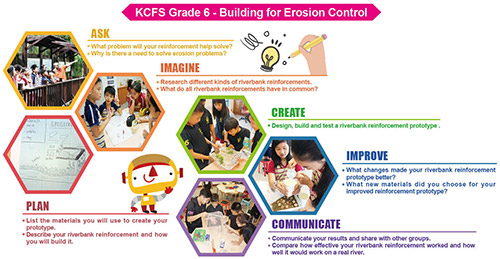
Enjoy the Winter Break!
國際處主任 賴國宜
This semester we started a new program, Kang Chiao Future Skills, which has real-life situations and provides students opportunities to explore the study of science, technology, engineering and mathematics. It's exciting to see our grade 5 and 6 students engaging in the hands-on lessons which make math and science more fun to learn. Today, scientific and technological innovations have become more and more important. The goal of our KCFS curriculum is to spark student interest in the study of STEM fields in order to better succeed in the highly technological society of the future.
We are coming to the end of the semester. I would like to wish all of our families a wonderful winter vacation with lots of quality time together.
根據美國商業部的報告,近來STEM相關領域的工作成長17%,培育STEM領域的人才攸關國家未來的經濟競爭力。STEM代表科學、科技、工程和數學,這學期五六年級新增Kang Chiao Future Skills 課程,融入STEM精神,設計跨領域的專題,讓孩子動手操作,解決一個實際的問題。這門課受到許多學生喜愛,老師們觀察到課堂的實作,提升孩子的學習參與,小組合作的活動,提供很多人際互動、團隊合作的機會,過程中,還學會運用相關的科學、科技、工程和數學知識,我們希望這樣的課程能讓孩子學會創新思考和解決問題,以面對未來更大的挑戰。
這一期我們還邀請三年級中籍英師Ms. Angel分享How a Kite Changed the World 專題,孩子們閱讀了富蘭克林發現電的故事,開始研究電的用途,歡迎您一起來欣賞孩子們介紹的便利電器用品。
期末考後,令人期待的寒假即將來臨,祝福大家有個愉快、充實的假期。

~ Gary Niemandt
Kang Chiao Future Skills Teacher, International Department
The Kang Chiao Future Skills program is based on the idea of educating students in four specific disciplines — science, technology, engineering and mathematics — in an interdisciplinary and applied approach. Rather than teach the four disciplines as separate and discrete subjects, KCFS integrates them into a cohesive learning paradigm based on real-world applications. In a world that’s becoming increasingly complex, where success is driven not only by what you know, but by what you can do with what you know, it’s more important than ever for our students to be equipped with the knowledge and skills to solve tough problems, gather and evaluate evidence, and make sense of information. These are the types of skills that students learn by studying science, technology, engineering, and math—subjects collectively known as STEM. Problem solving is really the heart of Kang Chiao Future Skills investigations. By asking students to brainstorm solutions, it brings their higher order thinking skills into play when we use the design process of ASK, IMAGINE, PLAN, CREATE, IMPROVE and COMMUINCATE.
In the “Ask” phase, students are presented with a real world problem. Students “Imagine” how they will solve this problem by researching solutions that already exist, and by looking into technologies that might be adaptable to their needs. Students work with a team to brainstorm ideas and develop as many solutions as possible. Revisiting the needs, constraints and research from the earlier steps, students then compare their best ideas, select one solution and make a “Plan” to move forward with it. Building a prototype in the “Create” phase makes their ideas real! These early versions of the design solution help each team verify whether the design meets the original challenge objectives. When it’s time to “Improve”, students discuss how they could improve on their solution. They make revisions and draw new designs. They iterate their design to make their product the best it can be. Then, students “Communicate” their results and get feedback. They analyze and talk about what worked, what didn’t and what could still be improved.

Kang Chiao Future Skills education focuses on the introductory level of STEM courses, as well as awareness of the STEM fields and occupations. This initial step provides standards-based structured inquiry-based and real world problem-based learning, connecting all four of the STEM subjects. The goal is to pique students' interest into them wanting to pursue the courses, not because they have to. To quote the National Science Foundation: “In the 21st century, scientific and technological innovations have become increasingly important as we face the benefits and challenges of both globalization and a knowledge-based economy. To succeed in this new information-based and highly technological society, students need to develop their capabilities in STEM to levels much beyond what was considered acceptable in the past.”

![]() 全文下載)
全文下載)